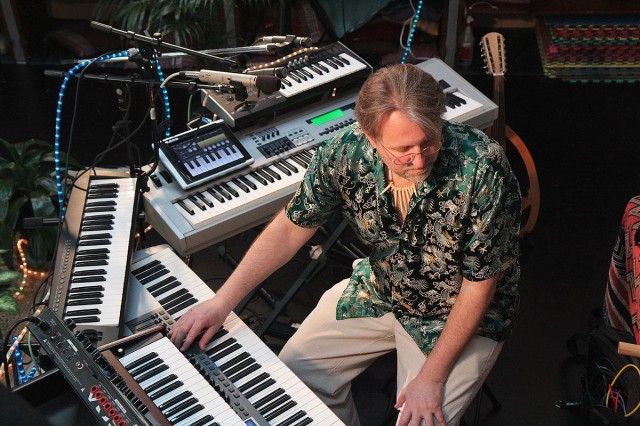It’s a collision between a twenty-first century tablet and some of the most iconic analog instruments ever produced. It’s MIDI and digital meeting up with control voltage and analog. It’s our friend Chris Stack, endeavoring to find the path that allows him to take the best pieces of his studio and put them together, pushing all that gear to its limits and finding a sum that exceeds the parts. In short, it’s music making, how a soloist can make an ensemble out of their tools. On ExperimentalSynth.com, Chris has been very interesting indeed. But it’s nice to pull together a few of these recent episodes to get a sense of the larger theme.
First, let’s have a look at Moog’s Animoog synth as it’s crossed with the Moog Voyager. Now, some will recall my original criticism of Animoog and iOS synths in general was the lack of tactile feedback on the iPad. But that makes Animoog’s support of MIDI significant. And put these instruments together with your hardware instruments, and something very different happens. (I find it interesting that the most active users of Animoog I’ve met all have it as an addition to a conventional hardware studio – it’s all pieces of the puzzle.)
Chris tells us this video has gotten an especially-enthusiastic response. The video demonstrates “some of the many possibilities when using the Moog Voyager as a MIDI controller for the Moog Animoog app and feeding the iPad audio back into the Voyager’s filter.”
What you may not have seen is the “extended,” “noir” version of that video:
But that’s just one direction to go with combinations of gear. Here’s a look at what happens when you augment a synth with outboard effects, also in this case from Moog Music. Chris writes:
These next two are a pair showing how to use the Env Out CV from the Moog MF-101 filter and MF-107 FreqBox to bring tempo-synced filter effects to the Voyager (which is somewhat limited in that regard compared to the LP and SP which have MIDI synced LFOs and arpeggiators). First the MF-101, then with a bit gnarlier and more complex setup with the FreqBox.
One thing you get out of computing platforms versus analog gear is worlds of sound that are impossible in the analog domain. That’s why it’s especially nice to see Chris combine csGrain, the out-there granular effect in Csound’s new incarnation on the iPad, with a Moog guitar:
But just as with desktop computers, a terrific role for mobile and tablets, particularly the MIDI-equipped iPad, is as a sequencer. The tablet interface becomes as natural an editing and composition tool as the gear is for tweaking and performance. Chris offers:
Here’s a really quick and dirty one I shot on my Droid while playing. It is on my other YouTube channel. Here I used the Koushion app to sequence the LP. The LP has the CV Out Upgrade so I sent the Pitch CV to the CP-251 which inverted it, then sent it to control the Voyager’s filter cutoff. As the LP note goes up, the Voyager Filter Cutoff goes down. This was all tied together through Ableton which was sending the same clock to a Line 6 Echo Pro so all the echos were synced to the same clock…
Of course, there’s a strong Moog Music emphasis in all these videos, but they all demonstrate more broadly where the productive overlaps of digital and analog can lie, adaptable to much humbler rigs and combinations.
If you find this sort of thing inspiring in your own music, you can follow Chris’ site directly:
http://experimentalsynth.com/
And give Animoog a try, or visit Moog Music:
http://apps.createdigitalmusic.com/apps/animoog
http://www.moogmusic.com/
We’ll be watching.
